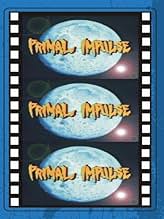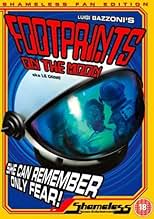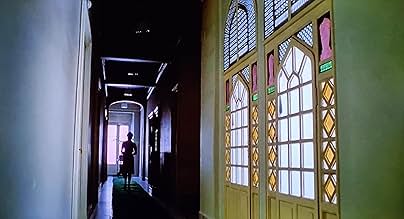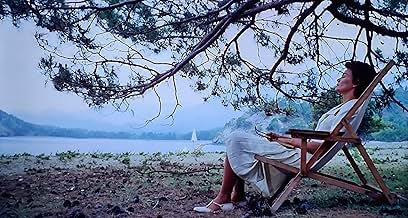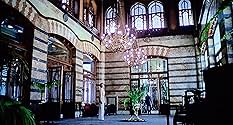IMDb रेटिंग
6.6/10
2.7 हज़ार
आपकी रेटिंग
अपनी भाषा में प्लॉट जोड़ेंAfter being tormented by dreams about astronauts on the moon, a translator visits a deserted seaside town whose inhabitants know her, although she does not know them.After being tormented by dreams about astronauts on the moon, a translator visits a deserted seaside town whose inhabitants know her, although she does not know them.After being tormented by dreams about astronauts on the moon, a translator visits a deserted seaside town whose inhabitants know her, although she does not know them.
John Karlsen
- Alfredo Laurenti
- (as John Carlsen)
- …
Miriam Acevedo
- Alice's Supervisor
- (as Myriam Acevedo)
Rosita Torosh
- Marie Leblanche
- (as Rosita Toros)
Bruno Degni
- Member of the International Congress
- (बिना क्रेडिट के)
Franco Magno
- Member of the International Congress
- (बिना क्रेडिट के)
Lidia Zanussi
- Member of the International Congress
- (बिना क्रेडिट के)
Luciano Zanussi
- Member of the International Congress
- (बिना क्रेडिट के)
Feridun Çölgeçen
- Hotel Concierge
- (बिना क्रेडिट के)
फ़ीचर्ड समीक्षाएं
This is why I love Italian gialli. Despite the somewhat true but nevertheless very tiresome claims that the Italian filmmakers are just rip-off artists, this one loose genre that only really had its heyday for a few years in the early 70's displays more originality and creativity than mainstream Hollywood films have in the last 20 years. (And some American fanboy directors like Quentin Tarantino have largely made their career by ripping THEM off).This film is not only unlike any other gialli; it's unlike any other movie I've seen. A woman (Florinda Bolkan) is haunted in her dreams by a long ago television show she saw of astronauts being left stranded on the moon. To relax she goes to an eerily deserted seaside resort town where she thinks she's never been , but where everyone seems to remember her visiting the week before. She gets more and more paranoid and confused. Meanwhile strange men in astronaut suits keep appearing. . .
Unlike the typically hysterical-from-the-get-go gialli, this movie gradually creates a sense of paranoia and unease. It mixes dream, reality, memory, and the media (television) to the point where the viewer is left as disoriented as the troubled protagonist. The end is bound to be a little disappointing after the build-up, but it's pretty memorable too.
While most gialli have an overabundance of characters, this movie is largely carried by Bolkan. Fortunately, she is more than up to the task. Bolkan was a Brazilian actress who, like Austrian beauty Marissa Mell, had a career that was often overshadowed by her personal life (and she probably didn't help this with her lesbian affairs and public claims of having been JFK's last lover). Unlike Mell though she was much more than just a pretty face and her talent can readily be seen in movies like this, Fulci's "A Lizard in Women's Skin", and the nunsploitation classic "Flavia, the Heretic". Klaus Kinski and the Ida Galli also put in brief cameos in the movie, and unfortunately so does young Nicoletta Elmi (who was kind of the Dakota Fanning of 70's Italian films--not a terrible actress but one that appeared in so many films you start to look forward to seeing her on the back of a milk carton).
Director Luigi Bazzoni's first giallo "The Fifth Cord" just came out on DVD. Hopefully, this one won't be far behind. Snap it up if you like gialli or if just enjoy unique, well-made movies. Highly Recommended.
Unlike the typically hysterical-from-the-get-go gialli, this movie gradually creates a sense of paranoia and unease. It mixes dream, reality, memory, and the media (television) to the point where the viewer is left as disoriented as the troubled protagonist. The end is bound to be a little disappointing after the build-up, but it's pretty memorable too.
While most gialli have an overabundance of characters, this movie is largely carried by Bolkan. Fortunately, she is more than up to the task. Bolkan was a Brazilian actress who, like Austrian beauty Marissa Mell, had a career that was often overshadowed by her personal life (and she probably didn't help this with her lesbian affairs and public claims of having been JFK's last lover). Unlike Mell though she was much more than just a pretty face and her talent can readily be seen in movies like this, Fulci's "A Lizard in Women's Skin", and the nunsploitation classic "Flavia, the Heretic". Klaus Kinski and the Ida Galli also put in brief cameos in the movie, and unfortunately so does young Nicoletta Elmi (who was kind of the Dakota Fanning of 70's Italian films--not a terrible actress but one that appeared in so many films you start to look forward to seeing her on the back of a milk carton).
Director Luigi Bazzoni's first giallo "The Fifth Cord" just came out on DVD. Hopefully, this one won't be far behind. Snap it up if you like gialli or if just enjoy unique, well-made movies. Highly Recommended.
A slow-moving film which retains a certain cult ; it seems it's all in a dream ,or a nightmare more like ; few special effects,no gore, but a great sense of mystery,with an open ending which will make all viewers interpreting the meaning of this bewildering story according to their own sensitivity .
With its deja vu feeling, its bizarre characters (Lila Kedrova) , its strange experiments on the moon , one can wonder whether the heroine is losing her mind, or is it a recurrent nightmare ? Its atmosphere sometimes recall "carnival of souls" ,probably the first important indie in the history of cinema .The beauty of Florinda Bolkan and the threatening face of Klaus Kinski add to the fascinating and deadly charm of this offbeat work.
With its deja vu feeling, its bizarre characters (Lila Kedrova) , its strange experiments on the moon , one can wonder whether the heroine is losing her mind, or is it a recurrent nightmare ? Its atmosphere sometimes recall "carnival of souls" ,probably the first important indie in the history of cinema .The beauty of Florinda Bolkan and the threatening face of Klaus Kinski add to the fascinating and deadly charm of this offbeat work.
I consider this a missed opportunity. I have very fond memories of the filmmaker's debut, an interesting psychosexual oddity called La Donna Del Lago, and watching this I'm inclined to think that earlier film worked so well because the giallo had not been mapped down yet; so he was free to travel where it was novel at the time. Polanski got there that same year, but he was already a name and had Deneuve with him and so made the bigger splash. Film history has noted Repulsion.
This could have been even better. He has brought ambitious imagination with him, a visual palette of bright golden hues and relaxing blues, a sense of place and folded mysterious time with memory from Marienbad. He has Vittorio Storaro's eye behind the lens.
The opening is more than promising. A woman wakes up with no memory of three days past. She has just seen a dream, a feverish vision of astronauts staggering on blasted moonscapes, which she remembers is from a movie called the same as the one we're watching; but a movie she left without watching the ending. She goes to Italy to investigate, in an effort to bring these images into focus.
There it falls apart, in Italy incidentally. In the ten years since that first film that was in some ways a giallo ancestor the genre had come and was already on its way out. Between these two films Bazzoni had worked where it was the trend in the Italian industry, making a western and another giallo called The Fifth Chord. So when the more ambitious material for this came together, there were already footsteps he was expected to walk and had been trained to. The circumstances of a commercial movie industry were just so.
So for the middle part of the film we get a giallo worked from convention. The convoluted plot where each character withholds crucial information until the time is right, and the protagonist has to cobble together a puzzle from clues and red herrings. Much ado.
It comes full circle in the finale; the agents which she has imagined to be controlling her illusion return to pull her back into the fiction of the dream. It happens with extraordinary images of a stretch of empty cosmic beachside.
Bazzoni never made another film after this. In the meantime, Polanski had rocketed into Hollywood orbit and was already on his way out. I reckon that Bazzoni was one of our sad losses, but alas he never made it to France where money didn't always expect to fill a double-bill.
This could have been even better. He has brought ambitious imagination with him, a visual palette of bright golden hues and relaxing blues, a sense of place and folded mysterious time with memory from Marienbad. He has Vittorio Storaro's eye behind the lens.
The opening is more than promising. A woman wakes up with no memory of three days past. She has just seen a dream, a feverish vision of astronauts staggering on blasted moonscapes, which she remembers is from a movie called the same as the one we're watching; but a movie she left without watching the ending. She goes to Italy to investigate, in an effort to bring these images into focus.
There it falls apart, in Italy incidentally. In the ten years since that first film that was in some ways a giallo ancestor the genre had come and was already on its way out. Between these two films Bazzoni had worked where it was the trend in the Italian industry, making a western and another giallo called The Fifth Chord. So when the more ambitious material for this came together, there were already footsteps he was expected to walk and had been trained to. The circumstances of a commercial movie industry were just so.
So for the middle part of the film we get a giallo worked from convention. The convoluted plot where each character withholds crucial information until the time is right, and the protagonist has to cobble together a puzzle from clues and red herrings. Much ado.
It comes full circle in the finale; the agents which she has imagined to be controlling her illusion return to pull her back into the fiction of the dream. It happens with extraordinary images of a stretch of empty cosmic beachside.
Bazzoni never made another film after this. In the meantime, Polanski had rocketed into Hollywood orbit and was already on his way out. I reckon that Bazzoni was one of our sad losses, but alas he never made it to France where money didn't always expect to fill a double-bill.
This is actually a very good surreal mystery movie, despite the description that tries to sell it as a Sci-Fi movie. Balkan stars as a woman haunted by mysterious visions and lost memories that she is trying to piece together. She spends the majority of the movie trying to make sense of her visions. Very atmospheric and effective. It is true that Kinski does not appear very much in this film, but the staring actors are very good. There is only an English dubbed version available in the US, and the dubbing leaves something to be desired, but the actors do a very good job. The cinematography, by Academy Award winner Vittorio Storaro is excellent. An earlier Giallo by director Bazzoni, THE FIFTH CORD, is also excellent, and also lensed by Storarro.
Footprints on the Moon is an example of what could be described as a bloodless giallo. These were entries from the Italian sub-genre that were more directly psychological in approach. After the success of Dario Argento's The Bird with the Crystal Plumage in 1970, these more subtle gialli became scarcer on the ground and a host of serial killer flicks were the norm. Footprints harks back to the older style but adds a dash of 70's paranoid thriller into the mix. The result is a somewhat surreal film which has a decidedly enigmatic tone and effect. It was directed by Luigi Bazzoni and shot by Vittorio Storaro, who also was cinematographer on Crystal Plumage as well as the later Hollywood film Apocalypse Now (1979). This duo also worked together on the earlier classic style giallo The Fifth Cord (1971). Both their movies display restraint in terms of salacious material, while both look beautiful due to Storaro's consummate skill. The lunar material looks wonderfully off-kilter, the widescreen compositions are consistently great and the use of black and white to recall strange memories and dreams works extremely well.
It starts fantastically well with a startling opening segment set on the moon, where we see astronauts drag an unconscious compatriot and then abandon him. It turns out a female translator is dreaming about this, when she wakes she discovers she has no memory of the last three days. She recalls a film she saw many years earlier called 'Footprints on the Moon', a film that recalls her dream, where a scientific experiment is carried out where astronauts are left stranded on the moon to test them. She discovers a torn postcard addressed to her of a place she is sure she knows but does not know why, she travels to this off-season tourist area and meets several people who know her but whom she does not know herself.
This one is typified by a sustained atmosphere of dread and it really delves into the fragile psychology of the protagonist, who is very well played by Florinda Bolkan, who was one of the most talented of the performers to regularly appear in gialli. This role is a fairly complex one and benefits a lot from Bolkan's subtle skills. There is also an appearance from another giallo regular, Nicoletta Elmi, the little red headed girl who played oddball children in several films from the time. In this film, she is given a bit more to do and is a little more integral to the plot. Evelyn Stewart and Klaus Kinski appear briefly, the former as Bolkan's friend in Italy and the latter as the mad scientist Blackmann from the film-within-a-film. The location where most of the action occurs is the resort of Garma which is an otherworldly dream-like place, with a vaguely Arabic feel and ruins; it feels like a dying place. The film feels like a combination of dreams, reality and movies. The science fiction film-within-a-film is a strong idea and the image of the abandoned astronaut is a peculiar and compelling one. This sci-fi thread blends into the fabric of the main story and that by the unforgettable final moments it has encroached entirely into Bolkan's reality. It's a memorably surreal way to end one of the most distinctive films in the giallo sub-genre.
It starts fantastically well with a startling opening segment set on the moon, where we see astronauts drag an unconscious compatriot and then abandon him. It turns out a female translator is dreaming about this, when she wakes she discovers she has no memory of the last three days. She recalls a film she saw many years earlier called 'Footprints on the Moon', a film that recalls her dream, where a scientific experiment is carried out where astronauts are left stranded on the moon to test them. She discovers a torn postcard addressed to her of a place she is sure she knows but does not know why, she travels to this off-season tourist area and meets several people who know her but whom she does not know herself.
This one is typified by a sustained atmosphere of dread and it really delves into the fragile psychology of the protagonist, who is very well played by Florinda Bolkan, who was one of the most talented of the performers to regularly appear in gialli. This role is a fairly complex one and benefits a lot from Bolkan's subtle skills. There is also an appearance from another giallo regular, Nicoletta Elmi, the little red headed girl who played oddball children in several films from the time. In this film, she is given a bit more to do and is a little more integral to the plot. Evelyn Stewart and Klaus Kinski appear briefly, the former as Bolkan's friend in Italy and the latter as the mad scientist Blackmann from the film-within-a-film. The location where most of the action occurs is the resort of Garma which is an otherworldly dream-like place, with a vaguely Arabic feel and ruins; it feels like a dying place. The film feels like a combination of dreams, reality and movies. The science fiction film-within-a-film is a strong idea and the image of the abandoned astronaut is a peculiar and compelling one. This sci-fi thread blends into the fabric of the main story and that by the unforgettable final moments it has encroached entirely into Bolkan's reality. It's a memorably surreal way to end one of the most distinctive films in the giallo sub-genre.
क्या आपको पता है
- ट्रिवियाOn Mill Creek's 50 movies set "Sci-Fi Invasion", the movie is available under its alternate title "Primal Impulse".
- गूफ़Crew member visible reflected in mirror when Alice wakes up in the Peacock Room.
- भाव
Alice Campos: I'm not crazy!
- कनेक्शनReferenced in Best of the Worst: The Vindicator, Cyber Tracker, Robot Jox, and R.O.T.O.R. (2013)
टॉप पसंद
रेटिंग देने के लिए साइन-इन करें और वैयक्तिकृत सुझावों के लिए वॉचलिस्ट करें
- How long is Footprints on the Moon?Alexa द्वारा संचालित
विवरण
- रिलीज़ की तारीख़
- कंट्री ऑफ़ ओरिजिन
- भाषा
- इस रूप में भी जाना जाता है
- Footprints on the Moon
- फ़िल्माने की जगहें
- उत्पादन कंपनी
- IMDbPro पर और कंपनी क्रेडिट देखें
- चलने की अवधि1 घंटा 36 मिनट
- ध्वनि मिश्रण
- पक्ष अनुपात
- 1.85 : 1
इस पेज में योगदान दें
किसी बदलाव का सुझाव दें या अनुपलब्ध कॉन्टेंट जोड़ें



